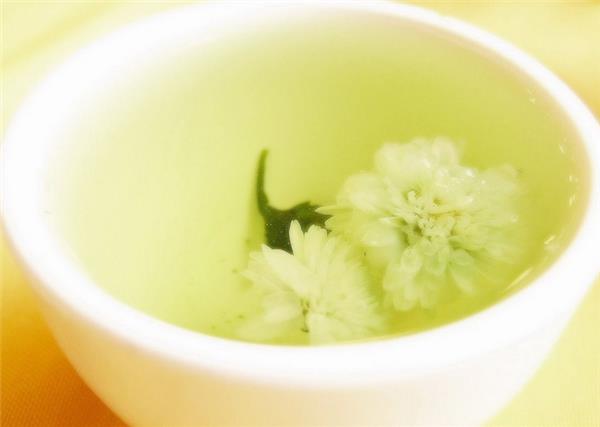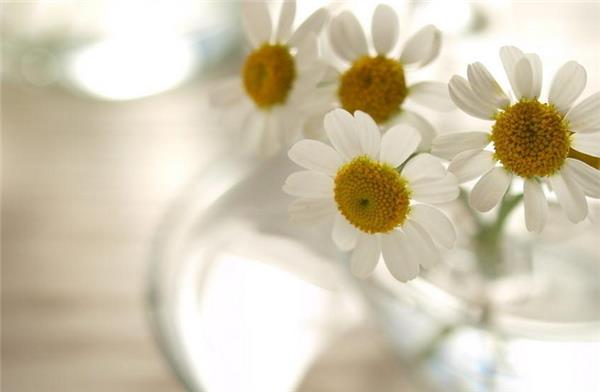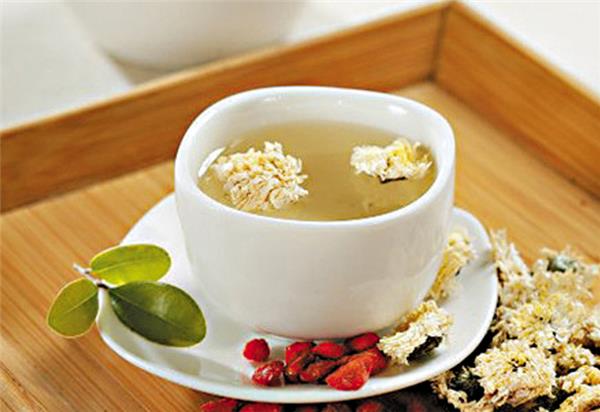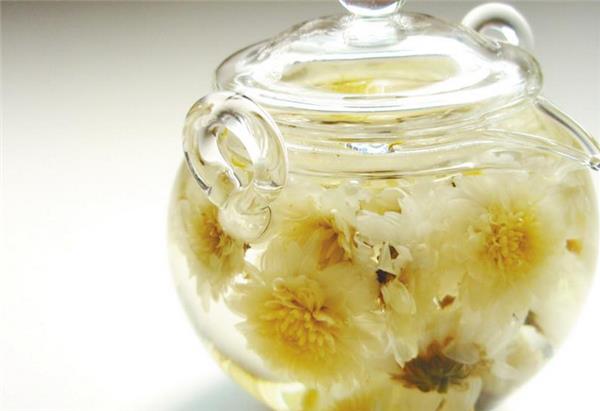What are the effects and functions of chrysanthemum tea
Chrysanthemum tea is our favorite drink, in the hot summer, sit in the beverage shop, order a cup of chrysanthemum tea, drink slowly, this kind of life is not comfortable, but do you understand the efficacy and function of chrysanthemum tea?

I. the efficacy and function of chrysanthemum tea
Chrysanthemum tea has a strong aroma, refreshing and refreshing, and also has the effect of relaxing nerves and relieving headache. Traditional Chinese medicine is mainly used to treat red eyes, sore throat, tinnitus, wind-hot cold, headache, high blood pressure, sores and other diseases. If long-term consumption, there are "blood gas, light body, prolong years" effect.
Scientists have confirmed that chrysanthemum tea contains volatile oil, inulin, adenine, amino acids, choline, stachydrine, small tiller, flavonoids, inulin, vitamins, trace elements and other substances, which can resist pathogens and enhance capillary resistance.
The flavonoids have been proved to have a strong scavenging effect on free radicals and are effective in anti-oxidation and anti-aging. From the point of view of nutrition, the essence of plants lies in flowers and fruits. There are 17 kinds of amino acids in the petals of chrysanthemum, among which glutamic acid, aspartic acid and proline are high. Chrysanthemum is also suitable for drinking with a variety of flowers and tea, the effect is more significant.
Side effects of chrysanthemum tea
Chrysanthemum is also a kind of traditional Chinese medicine and should not be abused. Chrysanthemums can not only cause severe allergic conjunctivitis, especially people with a history of subtilis febrile conjunctivitis need special attention, because such people taking chrysanthemums are also prone to allergic reactions. People with physical deficiency and cold, that is, people with Yang deficiency physique, if they blindly drink chrysanthemum tea with the effect of clearing away heat and purging fire, it is easy to damage vital qi, drink more and more deficiency, and thus aggravate the symptoms of pharyngitis. In general, chrysanthemum tea is most suitable for people with dizziness, red eyes, sore throat, liver fire and high blood pressure.

Chrysanthemums belong to pollen, people who are allergic to pollen should not drink them. If you want to drink chrysanthemum tea, you are advised to make one or two chrysanthemum teas first. If you have no problem, you should not drink too much, or you will be very troublesome if you are allergic. For people with diabetes or high blood sugar, it is best not to add sugar to drink chrysanthemum tea, and some people with spleen deficiency should not add sugar, because too sweet tea will lead to sticky mouth or sour mouth and more saliva.
When making chrysanthemum tea, it should be noted that the white chrysanthemum tastes sweet, the effect of calming the liver and eyesight is good, if the eyes are dry and uncomfortable, but the heat-clearing ability is slightly poor. Yellow chrysanthemum taste a little bitter, heat-clearing ability is strong, often used to dissipate wind and heat, if the fire, oral ulcers, soak in water with it can quench the fire. Wild chrysanthemum has a good effect on the prevention and treatment of meningitis, influenza and venomous snake bites, so these kinds of chrysanthemums should not be confused, let alone replace each other.
2. Cultivation of chrysanthemum
The main results are as follows: 1. Chrysanthemum is fond of fertilizer in the right period, if improper fertilization is easy to cause overgrowth, the plant height and leaves are sparse, so the base fertilizer should be based on phosphorus and potassium fertilizer. Topdressing should not be applied too early. If the leaves are small and thin and the leaves are yellowing, 0.1% urea water can be sprayed many times until they turn green. If there are symptoms such as phosphorus deficiency and potash fertilizer, 0.2% potassium dihydrogen phosphate solution should be sprayed. After the Beginning of Autumn to before flowering, fertilizer and water should be sufficient, its concentration should be gradually increased, and attention should be paid to the application of phosphorus and potassium fertilizer, which can make the flower color positive and the florescence long.
2. Proper water control is the only effective measure to make chrysanthemums grow sturdy, dense, fertilized leaves and not barefoot. Potted chrysanthemum should be watered in a timely and appropriate amount, and even in the peak growth period, the daily amount of water should only be maintained until the amount of water needed to evaporate at noon during the day, that is, spraying foliar water to the leaves every morning and evening.

3. In the whole growth process of chrysanthemum, it is generally necessary to change the pot for 3 times. At the seedling stage, the seedlings were transplanted into a small pot with a diameter of about 12 meters, and at the strong seedling stage, they were cultured in a pot with a diameter of about 15 meters, and before the flower buds were differentiated, they were cultured in a pot with a diameter of about 20 meters. Fertilizer should be applied at the right time. Only in this way, the flowerpot increases gradually and the pot soil increases gradually, which is beneficial to supply the right amount of water and fertilizer needed at all stages of growth and development. Do not raise small seedlings in large pots or big seedlings in small pots. If it is found that the branches and leaves are too abundant, part of the resident soil or fibrous roots can be removed.
4. Timely coring can promote lateral branches and effectively depress plant height. The coring time and times of potted plants vary according to different art of shape selection. Generally, 7 flowers are left. After planting, chrysanthemum seedlings are left with 5 leaves. When the lateral branches grow 5 leaves, each side branch leaves 3 leaves for the second coring.
5. In the strong seedling stage, the chrysanthemum sprouted many axillary buds, which should be pinched off with the fingers in time, otherwise a lot of nutrients would be consumed and many lateral branches could be sent out, which would make the plant look disorganized. During the bud period, side buds sometimes appear on the branchlets under the apical buds. In addition to those that need to be retained, they should also be removed as soon as possible to promote the hypertrophy of the parietal buds.
As the saying goes, "flowers still need green leaves." During the growth of potted chrysanthemum, reasonable fertilization, watering and prevention of diseases and insect pests can not only prevent foot leaves from withering and falling off, but also ensure that the leaves are green and beautiful, and improve the ornamental effect.

The above has made a detailed understanding of the efficacy and function of chrysanthemum tea, and also has an understanding of the cultivation of chrysanthemum tea. I hope everyone can continue to pay attention to chrysanthemum and be interested in chrysanthemum culture.
During the growth of potted chrysanthemum, reasonable fertilization, watering and prevention of diseases and insect pests can not only prevent foot leaves from withering and falling off, but also ensure that the leaves are green and beautiful, and improve the ornamental effect.

The above has made a detailed understanding of the efficacy and function of chrysanthemum tea, and also has an understanding of the cultivation of chrysanthemum tea. I hope everyone can continue to pay attention to chrysanthemum and be interested in chrysanthemum culture.
Related
- Wuhan Hospital Iron Tree Blooming Result Was Instantly Frightened by the Gardener Master
- Which variety of camellia is the most fragrant and best? Which one do you like best?
- What is the small blue coat, the breeding methods and matters needing attention of the succulent plant
- Dormancy time and maintenance management of succulent plants during dormancy
- Minas succulent how to raise, Minas succulent plant pictures
- What are the varieties of winter succulent plants
- How to raise succulent plants in twelve rolls? let's take a look at some experience of breeding twelve rolls.
- Attention should be paid to water control for succulent plants during dormant period (winter and summer)
- Watering experience of twelve rolls of succulent plants
- Techniques for fertilizing succulent plants. An article will let you know how to fertilize succulent plants.



